These vintage Parsnip Cakes or Parsnip Patties are inspired from a vintage 1940s wartime recipe that was published in a leaflet by The Ministry of Food [1944] titled - 'Vegetable Cookery'. However, parsnip cakes date back to at least the early 1700s as they were recorded in old British cookbooks. We have also included an optional dairy-free cheese sauce recipe as it pairs deliciously with these little parsnip patties but if you are not vegan or plant-based you can of course prepare your own preferred sauce or even go with a dollop of tomato ketchup, brown sauce, or mayonnaise. Parsnip patties can be easily prepared as gluten-free, and they can be fried, baked, or cooked using an air-fryer.
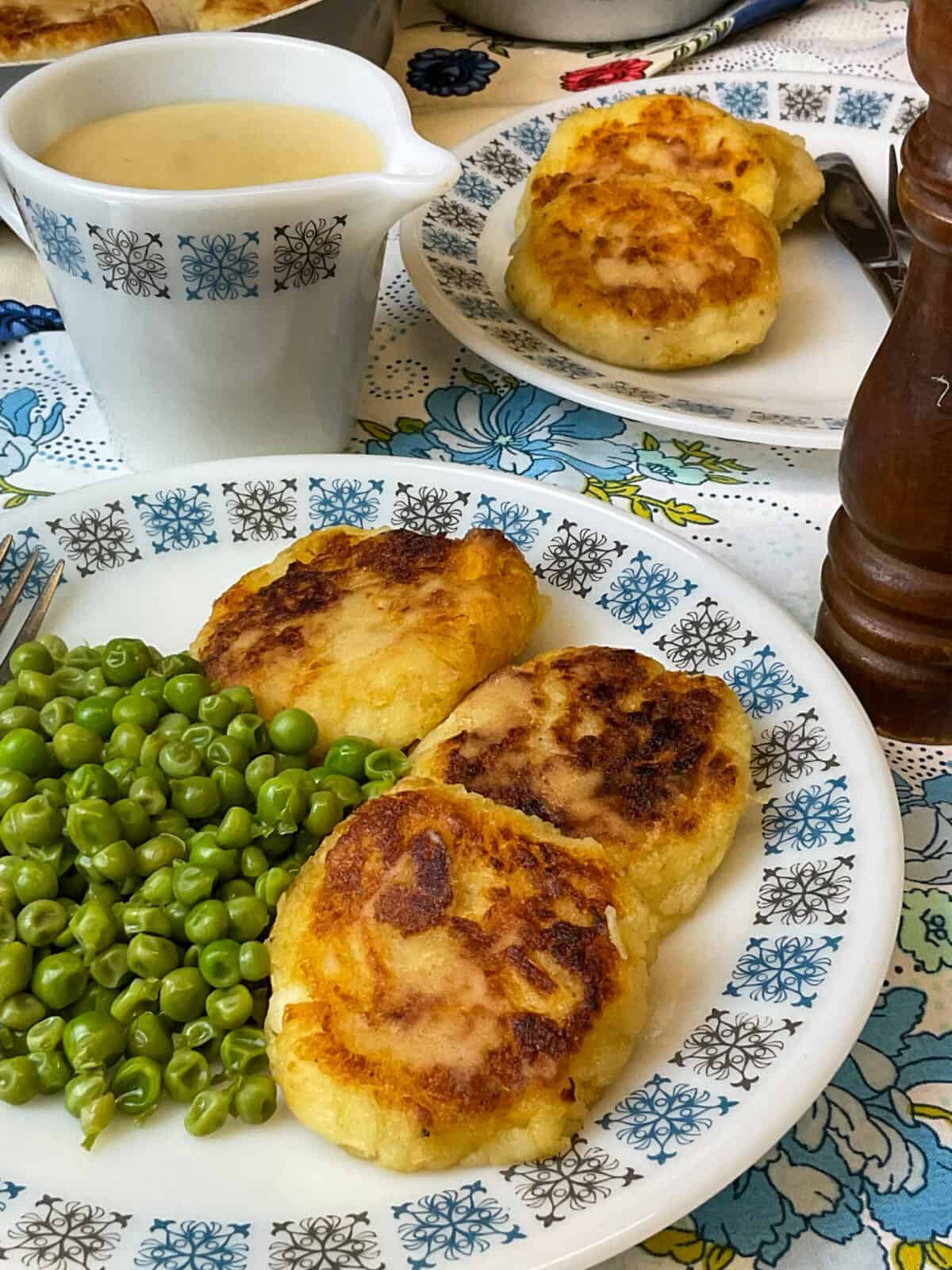
These parsnip patties or parsnip cakes are crispy on the outside and creamy on the inside. They are similar to a chunky potato scone or potato cake but are a little sweeter and packed with delicious nutty and earthy parsnip flavours. They are surprisingly very tasty and so good with a cheese sauce, tomato ketchup or brown sauce, or even a dollop of mayonnaise. Our parsnip patties can be cooked in an air-fryer or baked in the oven, however the traditional cooking method is to simply fry in a pan or skillet.
Jump to:
Origin of parsnips
The parsnip, a root vegetable closely related to the carrot, dates back thousands of years. Originally native to Eurasia, parsnips were cultivated by the Romans, who liked them for their sweet and nutty flavours. Before the arrival of sugar cane in Europe, parsnips was used as a natural sweetener for many recipes. Parsnips stored well throughout the winter so it was a staple vegetable throughout the Middle Ages. In the 16th century, parsnips crossed the Atlantic with the colonists to the Americas, where it became a staple in early American cuisine.
Once sweet potatoes were introduced to Britain during the 16th-17th Century they were welcomed as their sweetness was similar to parsnips. However the sweet potato soon became the more favoured root vegetable as evidenced from this historical statement which was referring to the sweet potato - ''The potatoe, a sweet roote which farre exceedeth our English parsnep'' [pg 366, Dorothy Hartley, Food in England, 2009]
Today, parsnips are still a popular root vegetable, particularly during the festive season, but as we now have access to a wider variety of vegetables, the parsnip is perhaps not as highly valued as it once was!
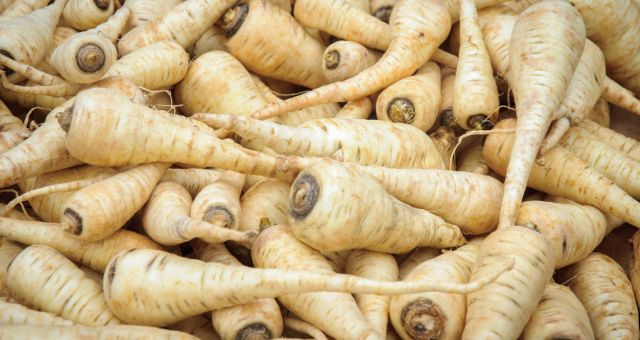
Image: Parsnips - sourced from Canva Pro.
1940s wartime recipes
Today's cost of living crisis is similar to what our ancestors and elderly relatives went through during the 1940s as for home-cooks this was a time of resilience, resourcefulness, and making-do with whatever was to hand.
Food was rationed and getting creative in the kitchen especially with vegetables was a financial necessity, so home-cooks had to discover new recipes to make delicious meals with limited ingredients.
Parsnips are naturally sweet so they were used in many 1940s wartime recipes especially for sweet recipes - such as sweet parsnip cakes, parsnip pudding, and mock banana sandwiches. For mock banana sandwiches parsnips were cooked until soft, mashed, and then sweetened with sugar and flavoured with banana essence, before being used as a sandwich filling!
Our parsnip patties recipe was inspired by a vintage recipe published in May 1944 by The Ministry of Food in the leaflet 'Vegetable Cookery' and was titled 'Parsnip Cakes'. The recipe states to use cooked parsnips so we have provided additional guidance for our recipe and included some useful information for cooking the parsnips. Our recipe ends up using more mashed parsnips and more flour than the original recipe but that just means more parsnip cakes or patties!
The patties are still relevant for todays families as they are a budget-friendly, easy, simple, wholesome and quick veggie dinner idea. The original recipe suggests serving the parsnip cakes with a cheese sauce but does not include a recipe, so we have included our family favourite plant-based cheese sauce recipe as it pairs beautifully with the patties.
For another easy, quick and delicious parsnip recipe do try our Curried Parsnip Soup.
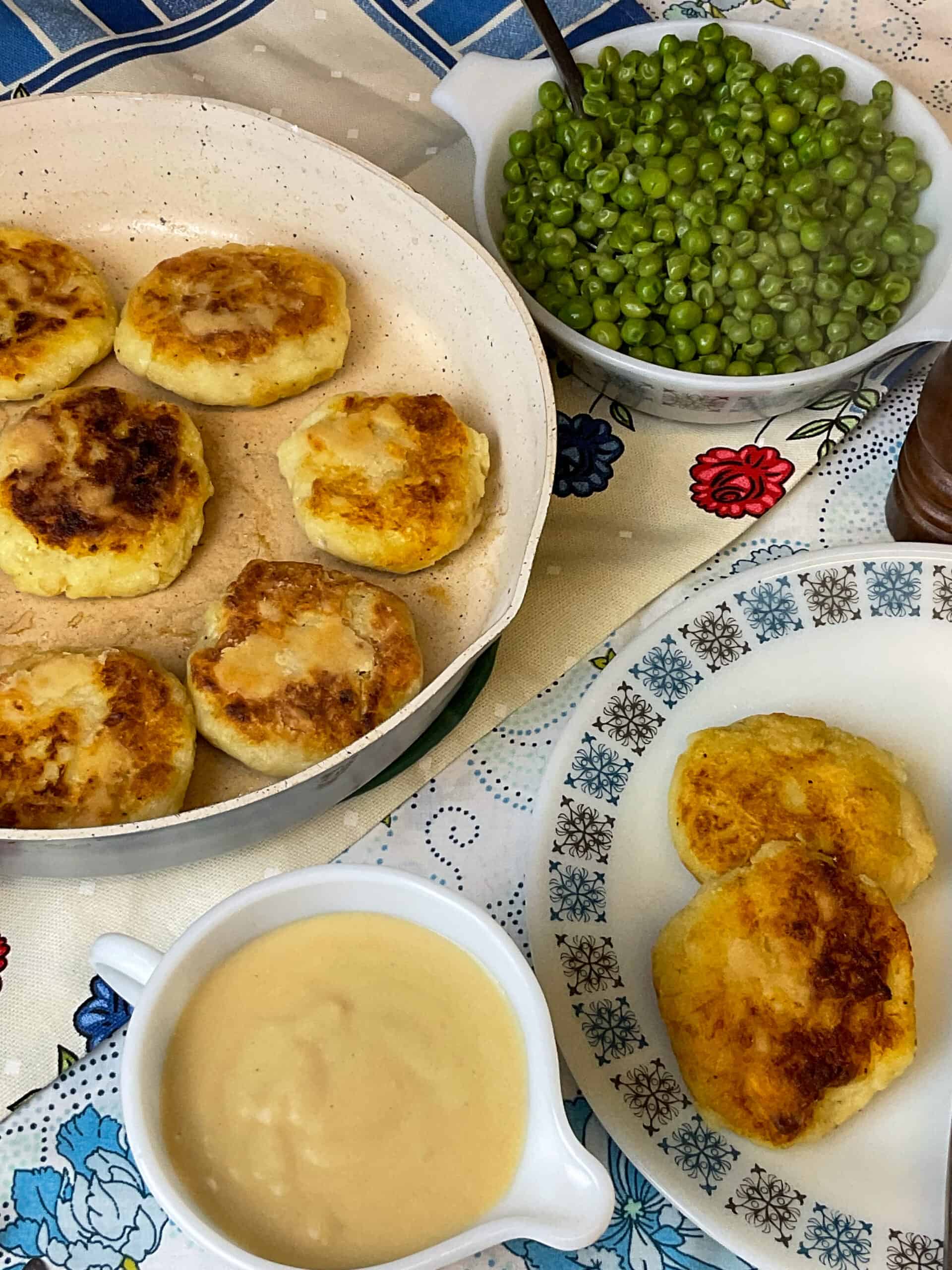
Parsnips make delicious patties but you can use different root vegetables for this patty recipe such as - sweet potato, potato, celeriac, swede [also known as a turnip in Scotland or a rutabaga in the US], carrots, etc. Or use a mix of root veggies for tasty mixed root vegetable patties. As this is a wartime recipe it is easily adaptable and wonderfully frugal.
How to prepare
The original Ministry of Food recipe simply states - 1 Ib cooked parsnips - in the ingredient list but for our recipe post we thought it would be useful to show how we prepped and cooked the parsnips as many people have not cooked parsnips before.
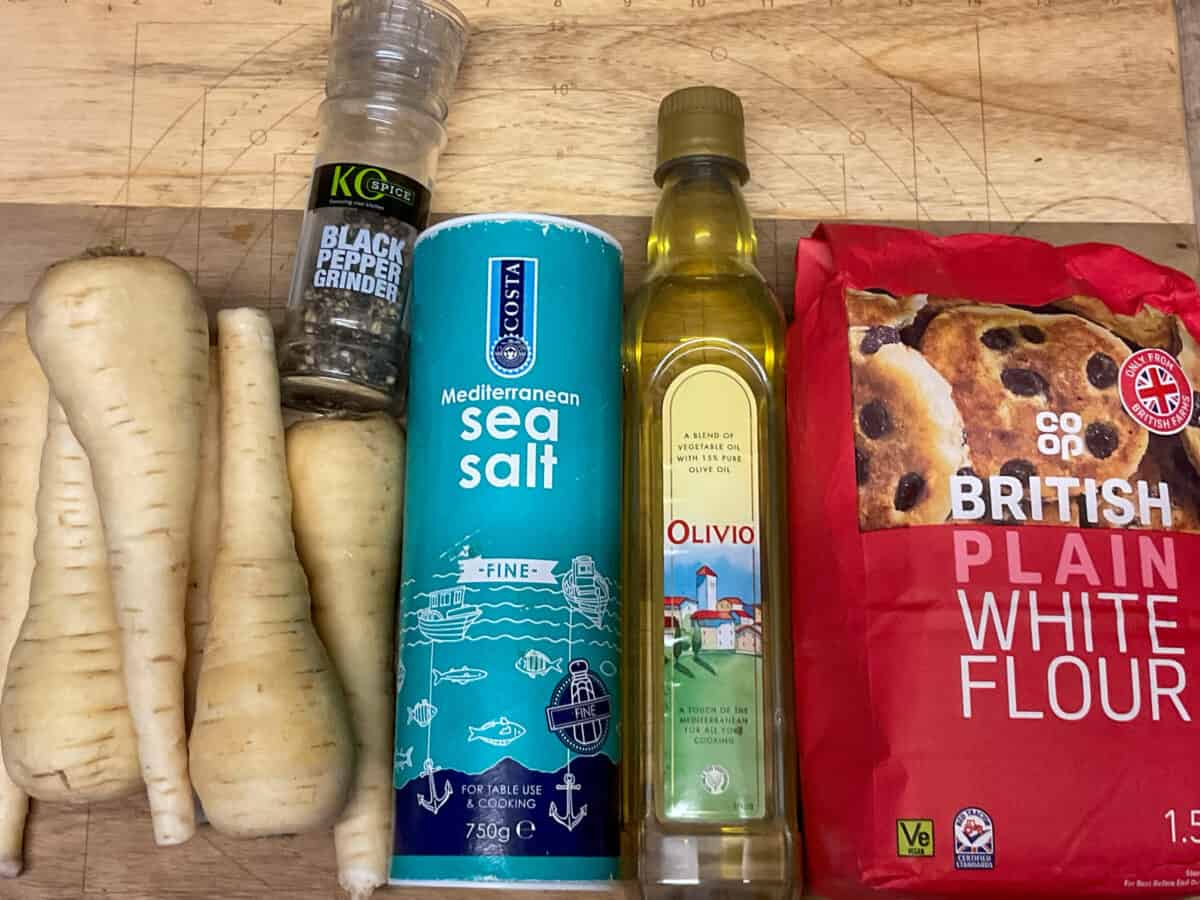
Step 1: Gather all your ingredients - parsnips, plain flour [all-purpose flour], vegetable oil, and salt and pepper.


Step 2: Prepare the parsnips by slicing the tops and bottom off, and peeling the parsnip skin. However, you don't have to peel all the skin off as it does contain valuable nutrition, so you can just remove any blemishes if preferred.
Step 3: Chop the parsnips into even sized chunks. Our parsnip chunks were around ¾ [three quarters] - 1 [one] inch in size. Add the parsnips to a saucepan of water and bring to the boil. Cook until soft. Our parsnips took about 10 minutes to soften.


Step 4: Drain the parsnips into a colander and set aside to steam dry for a few minutes.
Step 5: Add the parsnips to a mixing bowl and mash well with a potato masher.

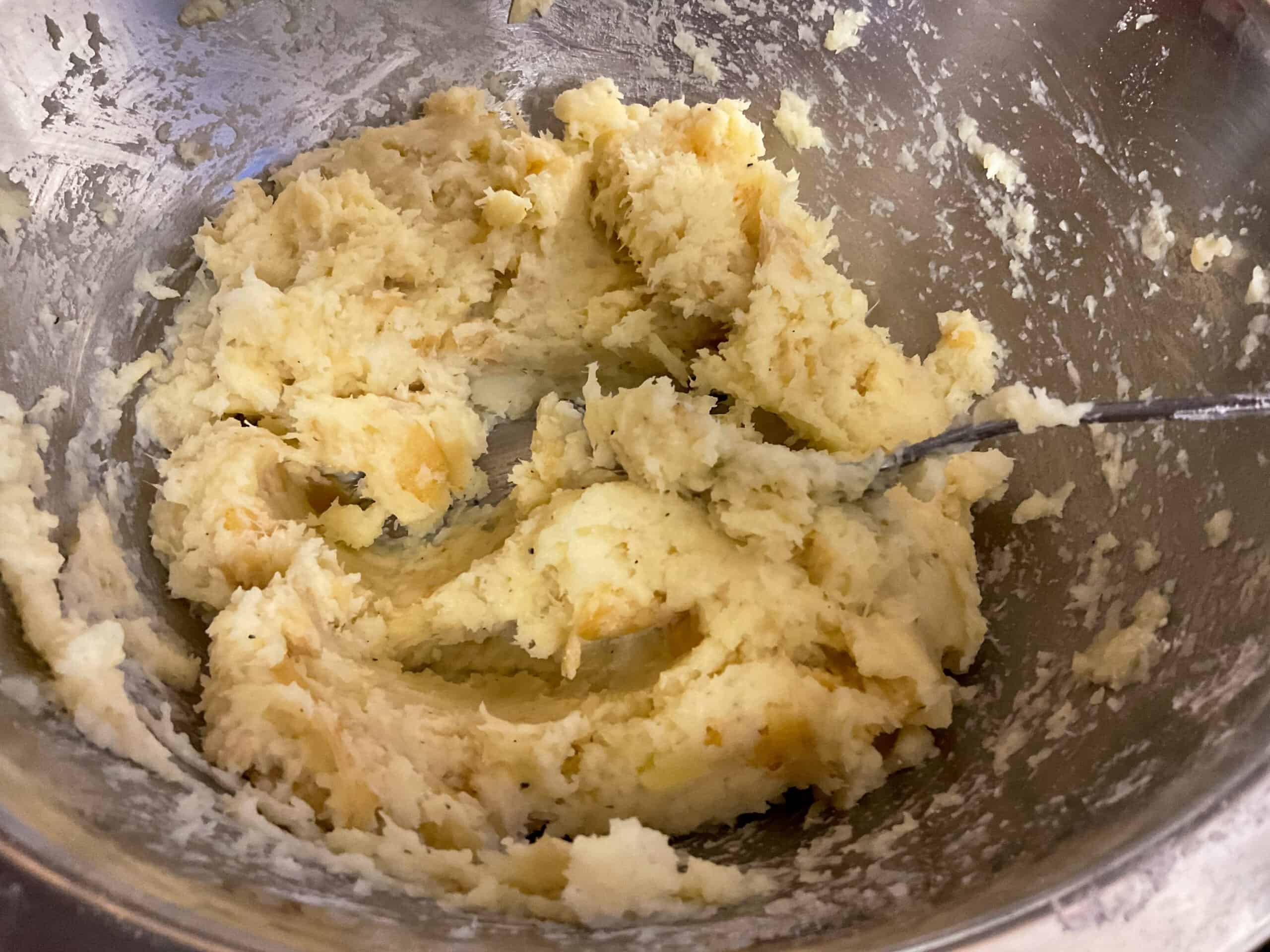
Step 6: Add the flour, and salt & pepper and stir well.


Step 7: Dust your hands with flour and form 11-12 chunky patties.
Step 8: Heat the oil in a frying pan or skillet. Cook the patties until golden brown on each side - about 4-5 minutes each side or a little longer.
If you would like to prepare air-fryer parsnip patties then have a look below at our FAQ section as we have outlined an easy guide, as well as included an easy method for oven baked parsnip patties.
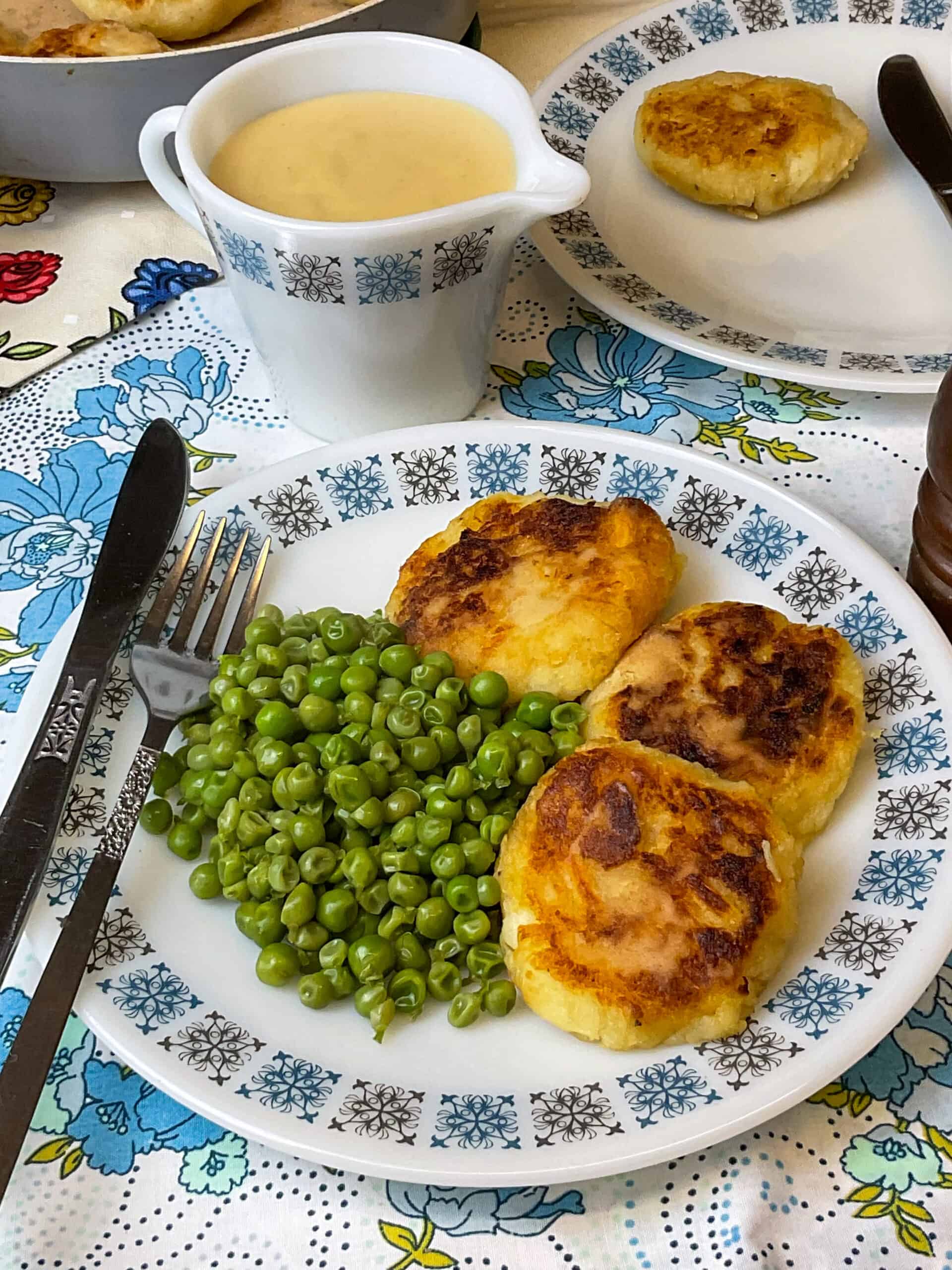
Serving suggestion: Enjoy with a green veggie such as peas, cabbage, kale, rocket [arugula], green beans, or a side such as vegan coleslaw, Boston baked beans, baked beans in tomato sauce, mushy peas, or our kids favourite - the easiest, quickest, and tastiest refried beans!
We also love some home-made dairy-free cheese sauce as an accompaniment as surprisingly cheesy peas are a delicious combination!
Optional accompaniment: Easy vegan cheese sauce recipe
This vegan cheese sauce recipe can be used for countless other meals not just for the parsnip patties. It can be cooled and chilled and enjoyed as a cheese spread or a cheesy dip along with some tortilla chips or crisps [chips], or spread over the top of a lasagna, or mixed with cooked pasta or macaroni pasta for a quick mac and cheese, poured over cooked cauliflower and baked for a quick cauliflower cheese, or added to a grilled cheese toastie instead of the cheese, or spread over the top of enchiladas, the list is endless!
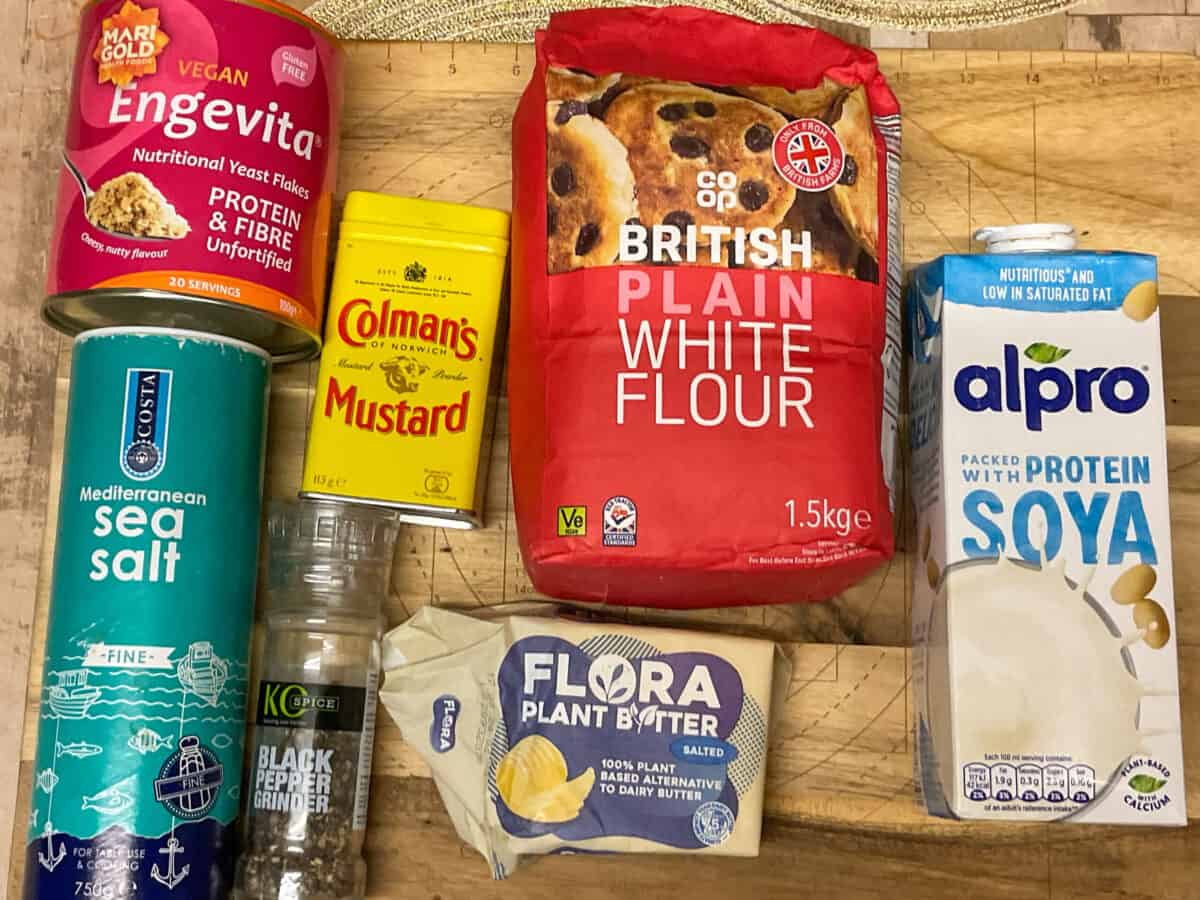
Step 1: Gather all the ingredients - plain white flour [all-purpose flour], vegan butter or margarine, plant-based milk [we used soya milk], mustard powder, nutritional yeast flakes [or replace with grated vegan cheese], and salt & pepper. Black pepper is shown in the above image but at the last minute we choose to use ground white pepper!


Step 1: Melt the vegan butter in a saucepan.
Step 2: Whisk through the flour and cook for 1 minute whisking constantly.


Step 3: Slowly add the milk whisking constantly to avoid lumps.
Step 4: Bring to a gentle boil and cook for 5 minutes, stirring frequently.
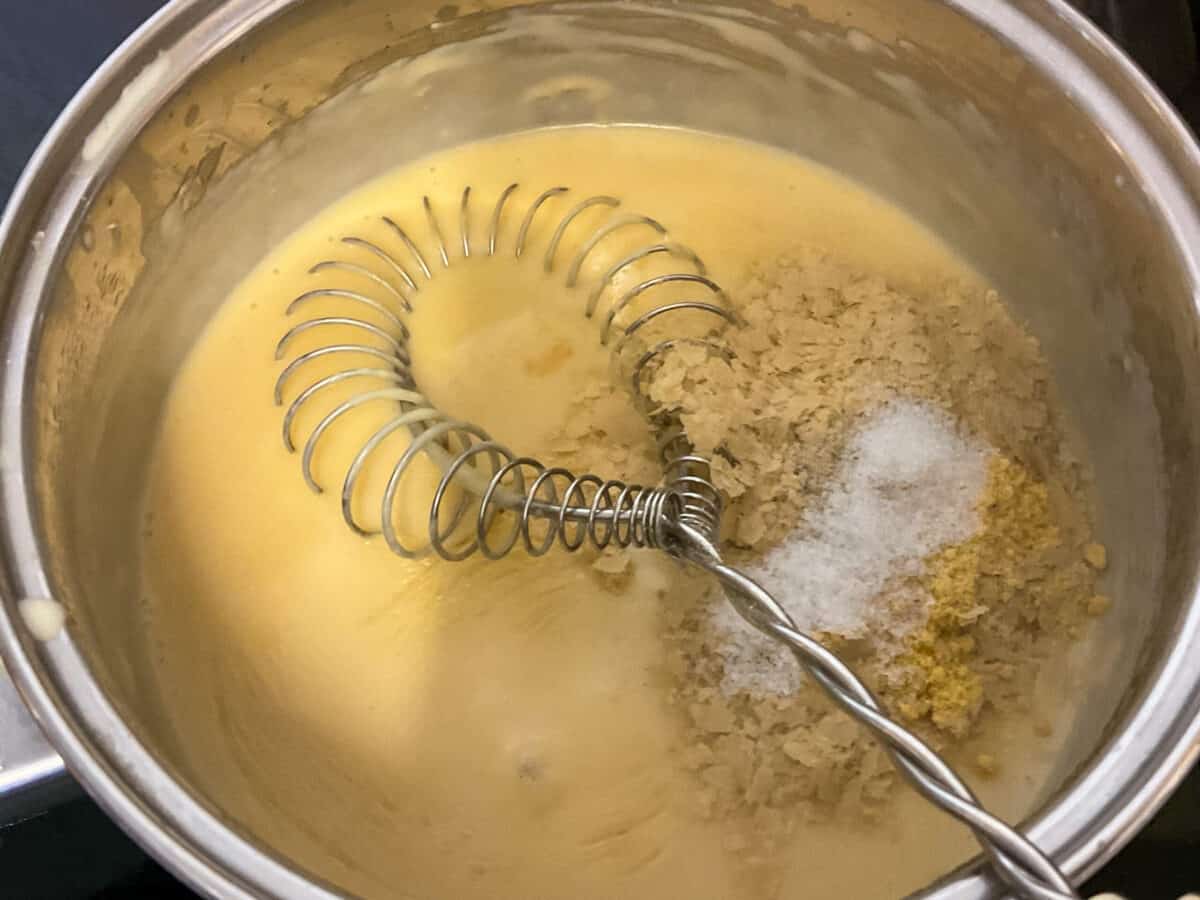
Step 5: Turn the heat off the stove top ring but leave the saucepan over the residual heat. Whisk through the nutritional yeast flakes, mustard powder, and salt and pepper, and stir for 30 seconds.
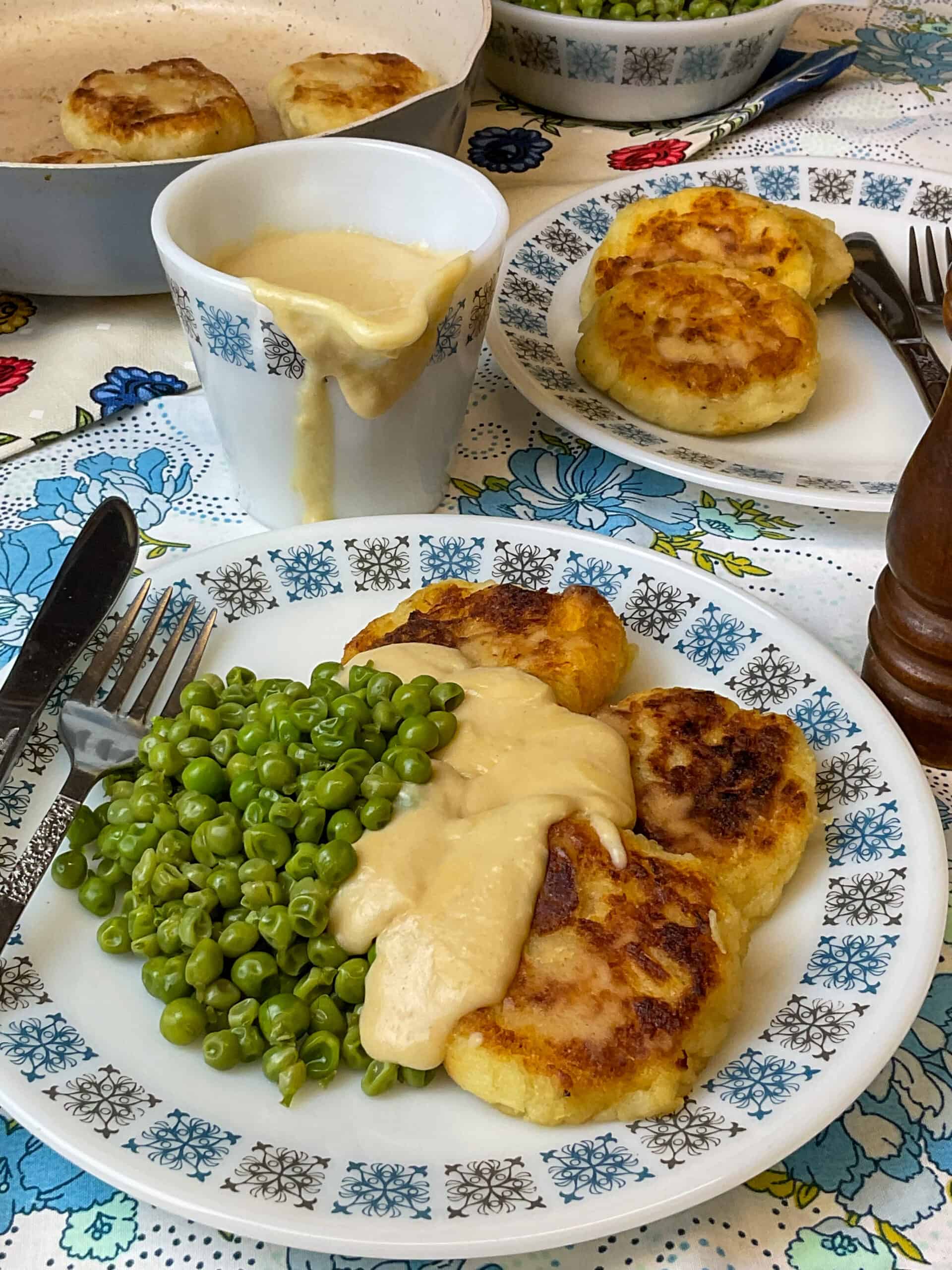
Serve the sauce up with the parsnip patties. This is a nice thick sauce but if a thinner sauce is preferred you can add a little more milk at the beginning or whisk it through a little at a time, once the sauce is ready just to thin it down.
Recipe notes
Storing
Store the patties in a covered container or plate in the refrigerator for up to 3 days. Add parchment or baking paper on to the bottom of the container or plate, and between the layers if stacking the patties. Or freeze for 3-4 months.
If you prepared the cheese sauce and have leftovers, then this can be stored within the refrigerator for up to 3 days.
Reheating
Reheat the patties by adding a small amount of oil into a non-stick fry pan or skillet and heat each side for a few minutes until the patties are piping hot throughout.
Or add the patties to an air-fryer and reheat until piping hot, flipping the patties over after a few minutes so that each side heats up.
Or pop the patties into a hot oven and heat through for 10 minutes before flipping the patties over and continuing to reheat for an extra few minutes or until piping hot.
FAQ'S
"Patties" also known as '' Cakes'' are similar to small chunky burgers and are usually prepared with ground or mashed ingredients, formed into a flat or thick, round shape, and then cooked. Any ingredient can be used for patties such as vegetables, beans, lentils, rice, meats, or fish.
The terms 'patties' and cakes' are often used interchangeably especially when referring to recipes made from vegetables, beans, or seafood - such as crab cakes and fish cakes. Historically, many British foods that were formed into circle or oval shapes were also referred to as 'cakes' even flat biscuits such as the Medieval Soul Cakes or the Scottish Oat Cakes. Also some traditional hot-pot style dishes have a cake-like shape and are also called 'cake' such as the savoury Welsh Onion Cake. Over in the US, savoury cakes are more likely to be called patties.
Yes, you can replace the parsnips with sweet potatoes, swede [turnip or rutabaga], celeriac, carrots, or butternut squash. Although do adjust the preparation and cooking times for each vegetable.
Yes, you can prepare mixed vegetable patties by using a few different cooked and mashed vegetables.
Yes, any leftover cooked mashed veggies are ideal for making home-made patties as they are a great way to repurpose the leftovers into another delicious meal. Once cooked, and before the flour and seasonings were added, our parsnips weighed in at 630grams which is just over 22oz so use that as a guide for preparing your leftover patties.
We use plain flour which is similar to all-purpose flour.
The plain flour can be replaced with a gluten-free plain flour blend or similar.
If preferred, you can replace the plain flour with a plain wholemeal or whole-wheat flour.
Yes, the patties recipe is a simple one as the salt and pepper seasonings are enough to bring out the delicious creamy sweet and nutty parsnip flavours.
However, you could add extra flavours such as curry powder, chilli powder, cayenne pepper, paprika, garlic powder, ground cumin, nutmeg, dried mixed herbs, etc. Alternatively, add a handful of finely diced fresh parsley, coriander, or chives.
For cheesy parsnip patties stir through some nutritional yeast flakes or grated vegan cheese or your preferred cheese.
Parsnips are a sweet and earthy root vegetable that are packed with natural sweetness. Parsnips are sweeter than carrots and also have earthy, woody and nutty tones. Many people also pick up on a slight spiciness similar to spices such as nutmeg or cloves. Once cooked, parsnips can have a creamy texture especially when mashed and if roasted with a syrup such as maple syrup or brown sugar the parsnips also develop delicious carnalized flavours.
Yes, using a ricer to mash the parsnips for the patties is a great idea especially if you're preparing the patties for a special occasion meal. A ricer is a kitchen tool that presses food through small holes, similar to a large garlic press. An old-fashioned recipe for parsnip cakes [cakes is a very old British word that refers to a variety of bakes but also patty shaped foods] from the 1700s states to pass the cooked parsnip through a sieve as this would have created a smoother parsnip mash, so using a ricer can achieve the same texture.
To bake the patties in the oven follow our easy guide:
1. Preheat your oven to around 170 Fan, 190C, 375 Fahrenheit, Gas 5
2. Follow the recipe to prepare the parsnip mixture and shape them into patties.
3. Line a baking sheet with baking or parchment paper or lightly grease it to prevent sticking. You can also use a silicone baking mat if you have one.
4. Place the patties on the baking sheet.
5. For more golden and crispy patties, you can lightly brush the tops of the patties with a small amount of oil. This step is optional but helps the outsides to crisp and brown, and can also add extra flavour.
6. Place the patties in the oven and bake for about 20-25 minutes. Halfway through the baking time, gently flip the patties over to ensure they brown evenly on both sides.
7. The patties are done when they are golden brown and crispy on the outside. The baking time might vary slightly depending on the size and thickness of your patties.
To cook the parsnip patties in the air-fryer use the following method as a rough guide and adjust the temperatures and cooking times according to your air-fryer.
Step 1: Switch your air-fryer to 190C to preheat for a few minutes. Preheating helps cook the patties evenly.
Step 2: Follow the recipe and form the parsnip patties.
Step 3: For crispy patties you can lightly brush or spray the patties with oil although this step is optional.
Step 4: Place the patties in the air fryer basket in a single layer, ensuring they don't overlap. You might need to cook them in batches, depending on the size of your air fryer basket.
Step 5: Air fry the patties for about 8-10 minutes. Then, carefully flip them over and continue to air fry for another 8-10 minutes. The exact time may vary based on your air fryer model and the size or thickness of the patties.
Step 6: The patties are ready when they are golden brown on each side. The cooking time might vary slightly, so it's a good idea to check them towards the end of cooking to ensure they don't overcook.
Using an air fryer not only reduces the amount of oil needed compared to pan frying, but it is also quick compared to baking in the oven and can save some money. Just remember that every air fryer is a bit different, so you may need to adjust the cooking time and temperature based on your specific air-fryer model.
We have included an easy recipe for a dairy-free cheese sauce as our family enjoys this sauce with these parsnip patties but of course if you have different dietary requirements you can use our recipe but use your usual milk and cheese.
Alternatively, these patties pair well with a variety of different sauces including - parsley sauce, peppercorn sauce, tomato ketchup, brown sauce, barbeque sauce, curry sauce, home-made tomato sauce, or a red pepper sauce. For a home-made parsley sauce you can use our cheese sauce recipe as a basis and omit the nutritional yeast flakes and instead stir through a handful of finely chopped fresh parsley.
Other ideas include mayonnaise, garlic aioli, creme fraiche, plain yogurt - and there are vegan versions of these readily available. Chutneys, pesto, and pickles are more tasty accompaniments as are apple sauce or cranberry sauce.
A green vegetable side is the perfect side dish to parsnip patties - such as steamed or roasted broccoli, Brussels sprouts, green beans, peas, asparagus, kale, cabbage, spinach or wild rocket [arugula]. A nice crispy salad is also a nice idea.
Other sides to pair with patties include rice, barley, quinoa, brown lentils, coleslaw, potato salad, pickled veggies, chutney, applesauce, cranberry sauce, hummus, guacamole, tzatziki, mayonnaise, baked beans in tomato sauce, mushy peas, or Boston baked beans.
Another tasty accompaniment is a wedge of crusty bread such as our Australian Damper Bread or Irish Soda Bread.
Alternatively, we love adding these parsnip patties to a buttered roll or bap along with some tomato ketchup, sort of like a Scottish potato scone [tattie scone] alternative. In Scotland, tattie scone breakfast rolls are very common in most cafes and eating places and parsnip patties breakfast rolls have become one of our new family favourites!
These parsnip patties would also make delicious burger sliders - add to small or mini baps or rolls along with some lettuce, tomato, cooked onions, etc. For the festive season or special occasions parsnip sliders would be a tasty starter dish enjoyed along with a fresh salad or prepare a tray of parsnip patty sliders for a party or buffet spread.
Top tips for making the best root veggie patties
- Keep your patties even in size and thickness as this ensures they cook evenly.
- If your patty mixture feels too soft, chilling it in the refrigerator for 30 minutes to an hour can make it easier to handle and help the patties hold their shape better while cooking.
- Always dust flour over your hands and work surface as this makes it easier to form the patties.
- Always use the stated amount of flour as this acts as a binder to prevent the patties from falling apart. Add a little extra flour if you think its required but don't add too much as you don't want to dry out the patties.
- Mix the ingredients just enough to combine them and don't overmix.
- Adjust the seasoning to your personal taste. Tasting the mixture before cooking can help you adjust the seasonings to your preference.
- Let the patties develop a crust on one side before flipping as flipping them too often can cause dents in the side of the patty.
- Make the patties your own by experimenting with different herbs, spices, and flavours. Patty recipes are adaptable and can be easily adjusted to suit your taste preferences and dietary needs.
More easy wartime veggie recipes
Potatoes, vegetables, beans, and lentils were readily available ingredients during the 1940s British wartime era so there were many inventive recipes available. The public was encouraged to 'Dig For Victory' which was a campaign to use any garden, park, or waste land space to plant veggies and other crops. Parsnips were easy to grow and with their hardy nature and high nutritional value, became a staple in many home gardens during this time.
Our family loves to try out vintage recipes from the 1940s so we have a growing collection of Wartime Recipes and many more are due to be added. If you would like to see a particular recipe featured on our family recipe blog then do drop us a comment and we will do our best.
Our family particularly enjoy this Vegan Cottage Pie which was more known as a potato lentil or bean pie during the war years, and as a delicious side this Potato Champ recipe is ideal as it contains hidden veggies - white cabbage and turnip [also known as swede or rutabaga]!
For the festive season this Old-Fashioned Christmas Pudding is so easy and reflects the British wartime kitchen ethos of being versatile and making-do as the pudding contains potato and carrot! It also is amazingly light with tasty notes of toffee!
Baking without eggs was a necessity back in the 1940s and these wee Eggless Chocolate Buns are perfect for any British wartime themed tea party or afternoon tea! Or just for everyday enjoyment as the chocolate buns are the best budget-friendly bake.
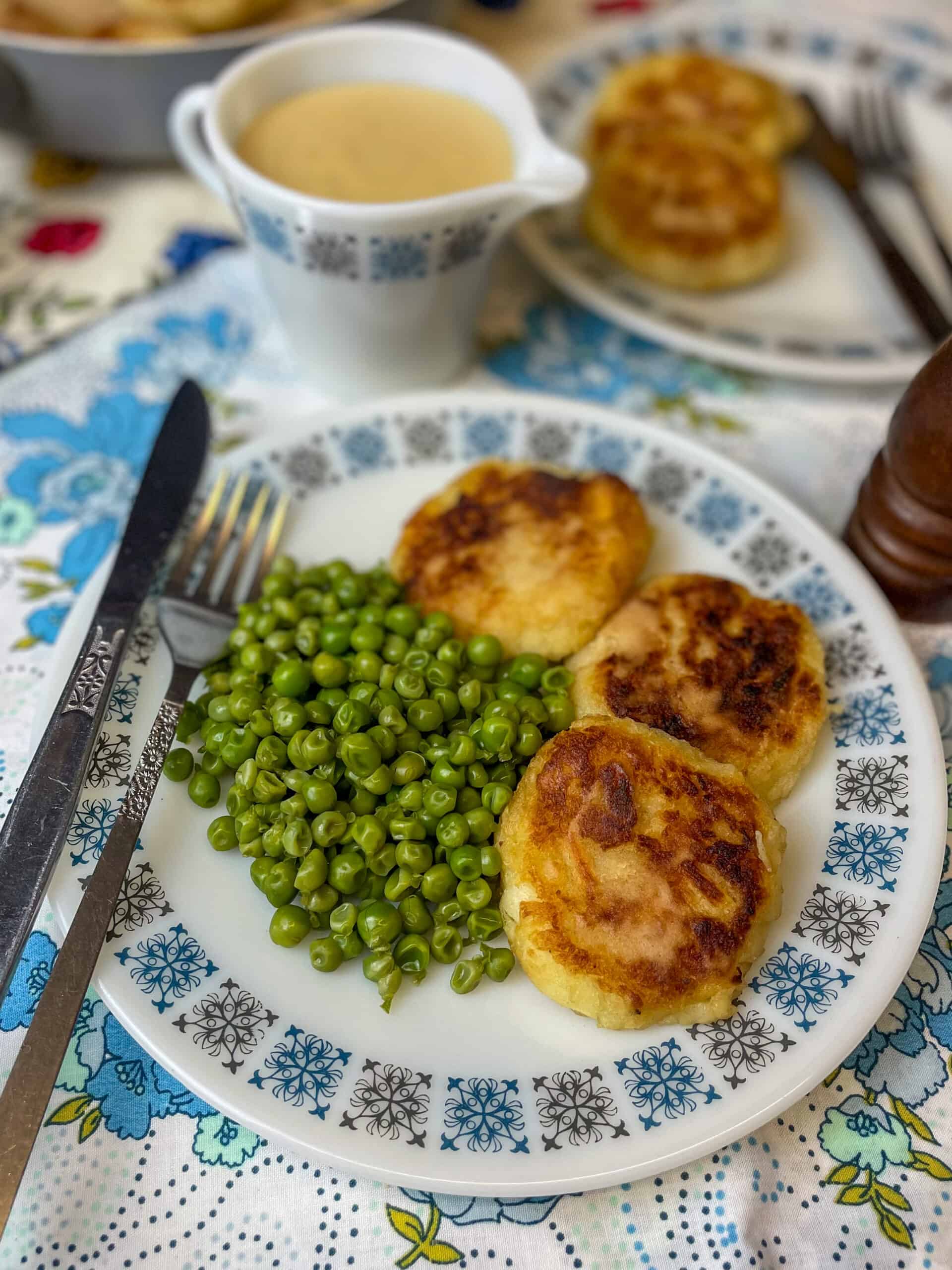
These veggie patties or savoury cakes are a great way to use up in-season root veggies that are usually sold cheaply in the UK supermarkets during the festive season. Parsnips thrive in the frosty weather as once this winter root vegetable has been subjected to a frosty spell they actually taste better as their starches break down and they become sweeter!
***please note: for US measurements click the 'US customary button' within the recipe and the measurements will switch to tablespoons, cups, and ounces.***
📖 Recipe
Parsnip Patties [1940s wartime recipe]
Equipment
- chopping board [cutting board]
- Vegetable knife
- vegetable peeler
- Large Saucepan
- Colander,
- non-stick fry pan or skillet
- Spatula
- optional cheese sauce equipment:
- Small saucepan
- hand whisk
Ingredients
- 750 grams parsnips
- 30 grams plain flour [all-purpose flour, or use whole-wheat flour or plain wholemeal flour] plus extra for dusting and forming patties
- 1 teaspoon salt [we used sea salt, plus black pepper to taste]
For frying:
- 2 tablespoons vegetable oil [add extra as required]
optional: vegan cheese sauce:
- 2 tablespoons vegan butter [or margarine]
- 2 tablespoons plain flour [all-purpose flour]
- 450 millilitres soya milk [or your preferred milk]
- 4 tablespoons nutritional yeast flakes [or replace with a handful of grated vegan cheese]
- ⅛ teaspoon ground white pepper [or replace with black pepper to taste]
- ¼ teaspoon mustard powder
- ½ teaspoon salt [add more to taste, we used sea salt]
Instructions
- Slice the top and bottom sections of the parsnips and peel. However, if the skins are unblemished you can leave the skins on for extra nutrition and if you don't mind a more rustic parsnip cake. Chop the parsnips into even sized chunks about ¾-1 inch in size.750 grams parsnips
- Bring a saucepan of water [optional- add a few pinches of salt to the water] to the boil and add the parsnip chunks. Boil over a medium heat until a cutlery fork or knife can piece through the chunks. Our parsnip took about 10 minutes to soften but exact times will depend on your parsnips and the size of the chunks.
- Drain the parsnips and leave to steam dry in a colander for a few minutes. [The parsnip cooking liquid can be reserved for other recipes such as parsnip soup.]
- Place the cooked parsnip into a mixing bowl and mash well with a potato masher.
- Add the flour and salt, and some black pepper, and give the parsnips a good stir. Taste the mixture and add extra salt to taste.30 grams plain flour, 1 teaspoon salt
- Sprinkle extra flour onto a chopping or cutting board, dust your hands with flour and form the parsnip mash into 11-12 thick patty shapes. You will likely need to keep dusting your hands with flour to avoid the patties sticking too much to your hands. Also dust some flour over a board or plate so that the patties can be placed on top of the flour whilst waiting to be cooked.
Cook:
- Heat the oil in a fry pan or skillet over a medium-high heat.2 tablespoons vegetable oil
- Fry the patties over a medium-high heat, flipping over after 4-5 minutes, until each side is golden brown. [If you would like to air-fry or oven bake the patties then have a look at our FAQ section above the recipe as we have outlined an easy guide]
- Once cooked the patties can be placed on to some baking paper and a baking tray and placed into a warm oven, just to keep warm until all the patties are cooked and ready to serve.
Serve:
- Serve up with your favourite sauce and green veggies such as peas, green beans, cabbage or kale. A cheese sauce was recommended by The Ministry of Food but a nice home-made tomato sauce, bottled ketchup or brown sauce, or a dollop of mayonnaise are tasty accompaniments. Other ideas is to enjoy the parsnip cakes as part of a cooked breakfast, or enjoy a breakfast roll [bap] filled with one or two parsnip cakes which would be similar to the very popular Scottish potato scone roll - which is simply a buttered roll with a potato scone [tattie scone].
Optional vegan cheese sauce:
- Melt the vegan butter in a saucepan over a medium heat.2 tablespoons vegan butter
- Whisk through the flour and cook for 1 minute whisking constantly.2 tablespoons plain flour
- Slowly add the milk whisking constantly to avoid lumps. Bring to a gentle boil and cook for 5 minutes, stirring frequently.450 millilitres soya milk
- Turn the heat off the stove top ring but leave the saucepan over the residual heat. Whisk through the nutritional yeast flakes, mustard powder, salt and pepper stirring for about 30 seconds. Alternatively. for a parsley sauce the nutritional yeast flakes can be omitted and a handful of finely diced fresh parsley can be stirred through. The mustard powder can be kept or omitted.4 tablespoons nutritional yeast flakes, ⅛ teaspoon ground white pepper, ¼ teaspoon mustard powder, ½ teaspoon salt
Notes
- Nutritional data is for guidance only and is not an exact calculation as ingredients vary.
- The nutrition data is for the parsnip patties.
- The nutrition data for the cheese sauce, divided into four servings is: One serving - 122 Kcal, 8g carbs, 7g protein, 7g fat, 1g saturated fat, 2g polyunsaturated fat, 2g monounsaturated fat, 0 cholesterol, 379mg sodium, 296mg potassium, 3g fiber, 145mg calcium, 0.02mg vitamin C, 507 IU vitamin A, 1 mg iron, and 0.5g sugar.
- Store the patties in a covered container or plate in the refrigerator for up to 3 days. Add parchment or baking paper on to the bottom of the container or plate, and between the layers if stacking the patties. Or freeze for 3-4 months.
- Reheat the patties in a frying pan or skillet, or in a hot oven, or in an air-fryer, until piping hot.
- This patties recipe is easy to double up if more patties are required, and unbaked but formed patties can be stored in the refrigerator for a few days until ready to cook.
- Extra seasonings can be added if liked such as curry powder, paprika, nutmeg, garlic powder, chilli powder, cumin powder, dried mixed herbs, etc., or nutritional yeast flakes for cheesy parsnip patties. Or add some finely diced fresh herbs such as chives, parsley, or coriander [cilantro].
- For gluten-free patties replace the flour with a gluten-free plain flour blend.
- If you would like to prepare air-fryer parsnip patties then have a look below at our FAQ section as we have outlined an easy guide, as well as included an easy method for oven baked parsnip patties.
- Optional cheese sauce recipe notes:
- The vegan cheese sauce will keep for 3 days within a covered container in the refrigerator.
- For a thinner cheese sauce add more milk at the beginning of preparing the sauce or thin the ready-made sauce down by whisking in some extra milk.
- Reheat the sauce by adding to a non-stick saucepan and over a low heat bring to a gentle boil and gently boil for a minute or so while stirring to avoid sticking. Whisk through a little extra milk if the sauce has become very thick.
- For different dietary requirements the vegan butter and plant-based milk can be replaced with your usual types.
- For the vegan cheese sauce nutritional yeast flakes can be replaced with vegan cheese or your usual cheese.
- Or instead of a cheese sauce prepare a parsley sauce by omitting the yeast flakes and replace with a handful of finely diced fresh parsley. The mustard powder can be omitted or left in.
- For air-fryer and oven baked patties have a look at our easy guide outlined above this recipe in our FAQ section.
Nutrition
Comments
Prepared our Parsnip Patties or Parsnip Cakes recipe? We would love to know how you got on with the recipe so do pop back and drop us a comment below and click the star ratings. It's very much appreciated. Thanks so much! Love Jacq x
Leave a Reply